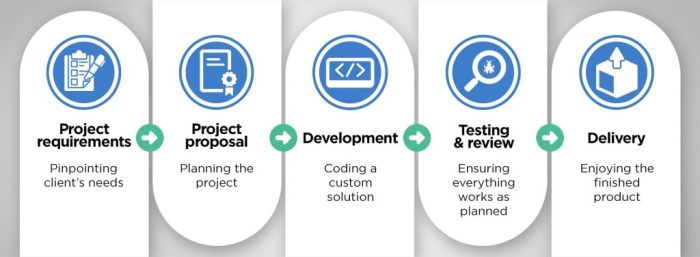The field of computer vision is rapidly evolving, transforming industries and impacting our daily lives in profound ways. From self-driving cars to medical image analysis, the applications are vast and constantly expanding. This comprehensive guide delves into the intricacies of computer vision software development services, providing a detailed understanding for both technical professionals and those seeking to leverage this powerful technology.
Understanding Computer Vision Software Development
Computer vision software development involves creating algorithms and systems that enable computers to “see” and interpret images and videos in a manner similar to humans. This process encompasses several key stages, including image acquisition, preprocessing, feature extraction, object detection, and image recognition. The ultimate goal is to extract meaningful information from visual data and use it to drive intelligent decisions or actions.
Key Stages in Computer Vision Software Development
- Image Acquisition: This involves capturing images or videos using various sources, such as cameras, scanners, or medical imaging devices. The quality of the acquired data significantly impacts the accuracy of subsequent processing steps. Factors like lighting conditions, resolution, and noise levels are crucial considerations.
- Preprocessing: Raw images often contain noise and artifacts that need to be removed or reduced before further processing. Common preprocessing techniques include noise reduction, image enhancement, and geometric transformations.
- Feature Extraction: This critical step involves identifying and extracting relevant features from the images. These features can be low-level, such as edges and corners, or high-level, such as objects and textures. Techniques like SIFT (Scale-Invariant Feature Transform) and SURF (Speeded-Up Robust Features) are commonly employed.
- Object Detection and Recognition: This stage focuses on identifying and classifying objects within an image or video. Deep learning techniques, particularly convolutional neural networks (CNNs), have revolutionized object detection and recognition, achieving state-of-the-art accuracy.
- Image Segmentation: This involves partitioning an image into meaningful regions or segments based on characteristics like color, texture, and shape. This is crucial for tasks like medical image analysis and autonomous driving, where precise delineation of objects is necessary.
Types of Computer Vision Software Development Services
Computer vision software development services cater to a wide range of needs and applications. Companies offering these services typically specialize in one or more of the following areas:
Custom Computer Vision Solutions
These services focus on developing tailored solutions to meet specific client requirements. This involves close collaboration with clients to understand their needs, design the system architecture, develop and test the algorithms, and deploy the solution. Custom solutions offer maximum flexibility and can be optimized for specific tasks and datasets.
Off-the-Shelf Computer Vision Tools and APIs
Several companies offer pre-built computer vision tools and APIs that can be integrated into existing applications. These solutions often provide a faster and more cost-effective approach compared to custom development, but they may not offer the same level of customization and flexibility.
Consulting and Training Services, Computer vision software development services
Many companies offer consulting services to advise clients on the best approaches to implement computer vision solutions. They can help clients choose the right technologies, develop data strategies, and train their teams on computer vision techniques. Training services can range from introductory workshops to advanced courses on deep learning and computer vision algorithms.
Technologies Used in Computer Vision Software Development
The development of robust and accurate computer vision systems relies on a combination of hardware and software technologies. Key technologies include:
- Programming Languages: Python, C++, and Java are commonly used for computer vision development. Python, in particular, boasts a rich ecosystem of libraries like OpenCV, TensorFlow, and PyTorch.
- Deep Learning Frameworks: TensorFlow, PyTorch, and Caffe are popular deep learning frameworks that provide tools for building and training complex neural networks for computer vision tasks.
- Hardware Accelerators: GPUs (Graphics Processing Units) and specialized hardware like FPGAs (Field-Programmable Gate Arrays) significantly accelerate the training and inference of deep learning models, making real-time applications feasible.
- Cloud Computing Platforms: Cloud platforms like AWS, Google Cloud, and Azure provide scalable computing resources and pre-trained models that can be used for computer vision development.
- Computer Vision Libraries: OpenCV is a widely used open-source library that provides a comprehensive set of functions for image and video processing, object detection, and other computer vision tasks.
Applications of Computer Vision Software Development
The applications of computer vision are vast and continue to expand. Some key areas include:
- Autonomous Vehicles: Computer vision plays a crucial role in enabling self-driving cars to perceive their surroundings, navigate roads, and avoid obstacles.
- Medical Imaging: Computer vision is used for analyzing medical images like X-rays, CT scans, and MRIs to detect diseases and assist in diagnosis.
- Robotics: Computer vision enables robots to perceive their environment and interact with objects, enabling them to perform tasks like assembly, manipulation, and navigation.
- Facial Recognition: Computer vision algorithms are used for facial recognition in security systems, access control, and law enforcement.
- Retail and E-commerce: Computer vision is used for inventory management, customer behavior analysis, and personalized recommendations.
- Agriculture: Computer vision is used for crop monitoring, yield prediction, and precision farming.
Choosing a Computer Vision Software Development Partner
Selecting the right partner for your computer vision project is crucial for success. Consider the following factors:
- Experience and Expertise: Look for a partner with a proven track record in developing successful computer vision solutions.
- Technical Skills: Ensure the partner possesses the necessary technical expertise in areas like deep learning, image processing, and relevant programming languages.
- Project Management Capabilities: A strong project management team is essential for keeping projects on track and within budget.
- Communication and Collaboration: Effective communication and collaboration are crucial for a successful partnership.
- Scalability and Maintainability: Ensure the solution can be scaled to meet future needs and is easily maintainable.
Frequently Asked Questions (FAQ)
- Q: What is the cost of computer vision software development? A: The cost varies greatly depending on the complexity of the project, the required features, and the chosen development approach. Custom solutions tend to be more expensive than off-the-shelf solutions.
- Q: How long does it take to develop a computer vision system? A: The development time depends on the project’s scope and complexity. Simple projects may take a few weeks, while complex projects can take several months or even years.
- Q: What type of data is needed for computer vision development? A: A large, high-quality dataset of labeled images or videos is crucial for training accurate computer vision models. The quantity and quality of data directly impact the model’s performance.
- Q: What are the ethical considerations of computer vision? A: Ethical considerations include bias in algorithms, privacy concerns, and potential misuse of facial recognition technology. Responsible development and deployment are crucial.
- Q: How can I ensure the accuracy of my computer vision system? A: Rigorous testing and validation are essential. This includes using appropriate evaluation metrics, testing on diverse datasets, and addressing potential biases.
References
Call to Action: Computer Vision Software Development Services
Ready to transform your business with the power of computer vision? Contact us today to discuss your project requirements and explore how our expertise can help you achieve your goals.

Source: visagetechnologies.com
FAQs
What types of industries benefit most from computer vision?
Many industries benefit, including healthcare (medical image analysis), manufacturing (quality control), automotive (autonomous driving), retail (customer analytics), and security (surveillance).
What is the typical cost of developing computer vision software?
Costs vary greatly depending on project complexity, data requirements, and the level of customization needed. It’s best to get a tailored quote from a development firm.
How long does it take to develop computer vision software?
Development timelines depend on project scope. Simple projects might take a few months, while complex projects could take a year or more.

Source: integrasources.com
What data is needed to train a computer vision model?

Source: neubrain.in
The type and quantity of data needed depend on the specific application. Generally, a large, high-quality dataset of labeled images or videos is required.
What are the ethical considerations surrounding computer vision?
Ethical considerations include bias in algorithms, privacy concerns related to image data, and the potential for misuse of the technology.
